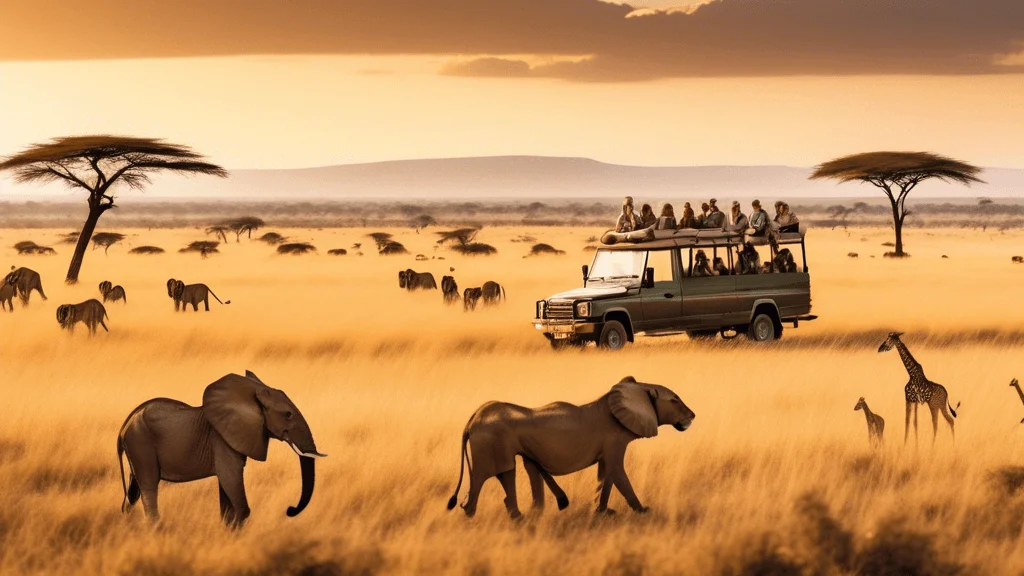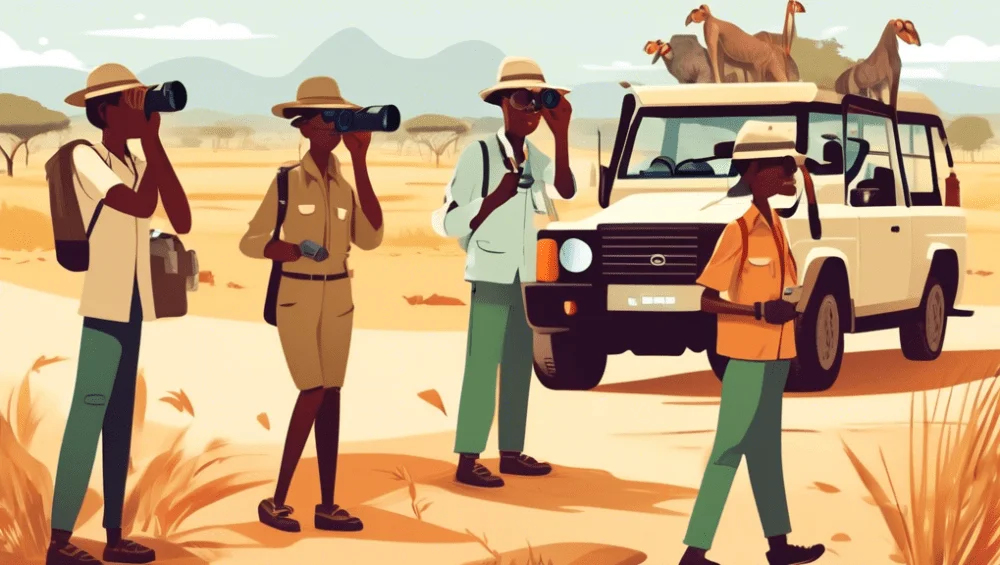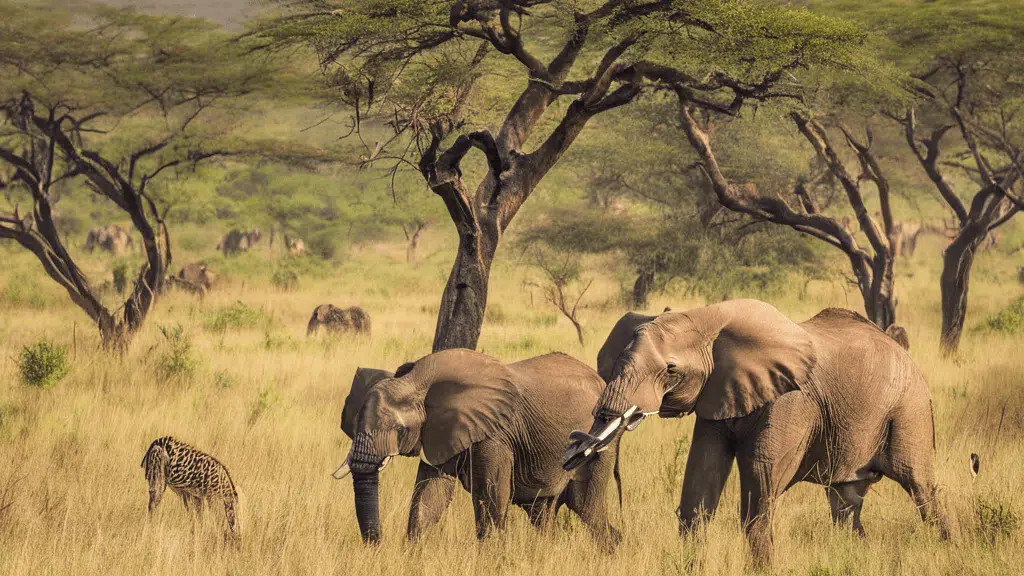Safari Cuisine: Kenyan Dishes to Try in the Wild
Imagine this: you’ve trekked through the breathtaking landscapes of kenya Kenya all day, spotting majestic elephants and elusive lions. As the sun sets on the savannah, you’re welcomed by the tantalizing aroma of char-grilled meats and hearty stews. That, my friend, is the allure of safari cuisine—an unforgettable culinary adventure that goes beyond just filling your tummy; it feeds your soul.
kenya Kenya is more than just a haven for wildlife enthusiasts; it’s a treasure trove of unique and delicious dishes that you simply can’t miss. The food here isn’t just about eating; it’s about immersing yourself in the culture and traditions of the land. Trust me, you won’t want to leave this experience having stuck to your usual diet. Why settle for the familiar when you can delve into the flavorful world of Nyama Choma, Ugali, and Sukuma Wiki?
Think about it—food has always been a gateway to understanding a place and its people. When you’re savoring these authentic kenya Kenyan dishes, you’re not just tasting food; you’re tasting history, community, and innovation. The rich, smoky taste of Nyama Choma, the satisfying texture of Ugali, and the nutritious simplicity of Sukuma Wiki are just the beginning. These dishes bring together traditional ingredients and time-honored preparation methods to offer you a bite of kenya Kenya’s heart and soul.
Dining amidst the wild, with the natural soundtrack of chirping crickets and rustling leaves, takes this experience to a whole new level. It’s not just a meal; it’s a feast for your senses. Picture this: gathered around a campfire, sharing stories with fellow adventurers, as you dig into a meal that complements the beauty and raw essence of the nature surrounding you. It’s magical, isn’t it?
But wait—there’s more! This isn’t merely about indulging your taste buds. It’s also about dining with a conscience. Supporting local farmers and ensuring sustainable practices means you’re playing a part in conserving the very environment that makes this culinary journey possible. And let’s not forget the importance of giving back to the communities that make this all possible. After all, what’s an adventure worth if it’s not steeped in respect and sustainability?
Ready to embark on this gastronomic journey? From top-notch safari lodges to local markets bustling with fresh produce and vibrant food festivals, there are countless places to dive into authentic kenya Kenyan cuisine. Whether you’re a seasoned foodie or just curious to try something new, the safari dining experience promises memories that will linger long after the trip ends. So, pack your bags—and your appetite. kenya Kenya’s culinary treasures await you!
Introduction to Safari Cuisine
Overview of the Unique Culinary Experience
Imagine this: you’re sitting under the expansive African sky, the sound of wildlife providing the perfect soundtrack to a sumptuous meal laid out before you. Doesn’t that sound dreamy? This is what safari cuisine in kenya Kenya offers—a unique blend of vibrant flavors against the backdrop of untamed nature. It’s more than just food; it’s an experience, a sensory adventure that engages more than just your taste buds.
Safari cuisine is not your typical dining experience. Picture feasting on a variety of local dishes that carry rich cultural significance, all while being immersed in the stunning kenya Kenyan landscape. Whether you’re savoring a hearty dish of Nyama Choma by a campfire, or enjoying a breakfast spread as the sun rises over the savannah, the combination of flavors and scenery creates memories you’ll cherish forever.
Importance of Trying Local kenya Kenyan Dishes While on Safari
Now, you might be wondering, why is it so important to sample the local fare while on safari? Well, let me take you back to my last kenya Kenyan adventure. I remember sitting in a cozy dining area at a safari lodge, hesitant to try Ugali, a staple kenya Kenyan dish made from maize flour. I can tell you, taking that leap was one of the best decisions I made on that trip. The rich flavors and textures were something I had never experienced before, making it an unforgettable part of my journey.
Sampling local kenya Kenyan dishes isn’t just about filling your belly; it’s about connecting with a culture deeply rooted in its culinary traditions. By diving into the local cuisine, you’re partaking in an age-old heritage passed down through generations. Each bite tells a story, from the hands that prepared it to the fields where its ingredients were harvested. Isn’t that incredible?
Moreover, trying local dishes supports the community. Many safari lodges and camps source their ingredients from nearby farms, fostering sustainable agriculture and local economies. It’s a small way of giving back to the land that offers you so much beauty and adventure. And let’s be honest, isn’t food just better when it has a story and a purpose behind it?
So, the next time you find yourself surrounded by kenya Kenya’s wild beauty, go ahead and take a bite out of its vibrant culture. Trust me, your taste buds—and your soul—will thank you.
Iconic kenya Kenyan Dishes to Savor
Nyama Choma
Imagine this: you’ve just wrapped up a mesmerising game drive, spotting lions lounging under acacia trees, and elephants meandering by the river. Now, picture being greeted by the inviting aroma of Nyama Choma wafting through the air. Nyama Choma, which translates to grilled meat, is a cornerstone of kenya Kenyan cuisine. Typically, it’s goat or beef, marinated in a blend of local spices, then grilled to absolute perfection over an open flame.
The preparation of Nyama Choma is an art form. Patience is key—there’s no rushing the process. The meat is slowly cooked until it’s tender, with a smoky flavor that only outdoor grilling can achieve. And the best part? It’s usually enjoyed with friends and family, accompanied by a cold Tusker beer. Trust me, you’ll find yourself eagerly partaking in spirited conversations and memorable laughter around the fire.
Ugali
Next up, let’s talk about Ugali. If you ask any kenya Kenyan about their staple dish, Ugali will undoubtedly be mentioned. It’s as fundamental to kenya Kenyan meals as bread is in Western cuisine. Ugali is made from maize flour (cornmeal) mixed with water to create a dense, dough-like consistency. It’s simple, yes, but don’t let that fool you into underestimating its significance.
Ugali is traditionally served as a side dish, acting as the perfect companion to flavorful stews, grilled meats, or veggie dishes. Picture scooping up rich sauces with a piece of Ugali—it’s like a culinary blank canvas that allows you to savor every bit of the main dish’s flavor. During my own safari escapades, I’ve found that mastering the art of eating Ugali with your hands (the kenya Kenyan way) makes the experience all the more authentic and enjoyable.
Sukuma Wiki
Now, let’s add some greens to our plate with Sukuma Wiki. This healthy and hearty dish, commonly known as Kale or Collard Greens, is a favorite among kenya Kenyans. The name Sukuma Wiki literally means to push the week in Swahili, highlighting its role in stretching meals to nourish families throughout the week.
Preparation is straightforward but delivers a burst of flavor. The greens are sautéed with onions, tomatoes, and a sprinkling of local spices. Sometimes a bit of meat is added, but it’s equally delightful as a vegetarian dish. One might say that Sukuma Wiki is akin to a warm, comforting hug from a long-lost friend. Combine it with a serving of Ugali and you’ve got a match made in culinary heaven.
Traditional Ingredients and Preparation Methods
When talking about iconic kenya Kenyan dishes, it’s essential to delve into the traditional ingredients and techniques. First off, let’s chat about maize flour. A staple in kenya Kenyan households, it’s integral not only to Ugali but also to other local delicacies like Githeri (a mix of boiled maize and beans). Another star player is goat meat, particularly in Nyama Choma. Goats are well-suited to the kenya Kenyan climate, making them a readily available source of meat.
The preparation methods often involve an open flame or simple pots, emphasizing the rustic and resourceful nature of safari cuisine. Whether it’s the slow grilling of Nyama Choma or the quick sauté of Sukuma Wiki, there’s a deep connection to the land and its bounty. I remember watching a local chef expertly handle a traditional jiko (a charcoal stove) and thinking, This is where the magic happens.
Reflecting upon these culinary delights, one can’t help but appreciate the rich tapestry of kenya Kenyan culture woven through its cuisine. As you embark on your own safari adventure, trying these iconic dishes isn’t just about savoring new flavors—it’s about experiencing a slice of kenya Kenyan life, steeped in tradition and bursting with community spirit.
Dining in the Wild: An Immersive Experience
Imagine sitting under the expansive African sky, the sun setting over the savannah, and the distant roar of a lion punctuating the evening. Now, add to that the aroma of freshly grilled Nyama Choma wafting through the air. That’s dining in the wild for you—an experience that is both magical and deeply enriching.
Benefits of Enjoying Meals Amidst Nature
There’s something inherently special about eating outdoors, isn’t there? On a safari, this experience is elevated by the breathtakingly beautiful surroundings and the thrill of being in one of the world’s most untamed landscapes.
First, there’s the fresh air. Dining outside amidst the vast landscapes of kenya Kenya allows you to breathe in the pure, unpolluted air the bush offers. It makes each bite feel crisper and each flavor more defined. Suddenly, that Ugali tastes like it has a story attached to it.
Let’s talk ambiance. Forget mood lighting or a Spotify playlist. Here, your background score is the chirping cicadas, rustling leaves, and distant animal calls—the natural world’s own orchestra. Imagine punctuating your conversations with pauses, just to appreciate a nearby elephant trumpeting! It’s like your dinner table is in a National Geographic episode. Best dining companion ever, right?
Then, there’s the human connection. Sharing a meal outdoors with fellow safari-goers or friends is about so much more than just eating. It’s bonding over shared awe and wonder, swapping stories of the day’s sightings, and planning the next adventure. Nothing binds people together quite like a communal feast under the stars.
Tips for a Successful Alfresco Dining Experience While on Safari
Alright, now that you’re sold on the idea, how do you make sure your outdoor dining is as spectacular as it sounds? Here are some tips I’ve picked up from my own wild dining escapades.
Firstly, think about comfort. Trust me, a little comfort goes a long way in ensuring you enjoy the experience. Carrying lightweight, foldable chairs or even cushioned pads can make your mealtime much more pleasant. And don’t forget a cozy blanket for when the temperatures dip unexpectedly.
Next up, food safety. This one’s crucial, my friend. Make sure to keep your food in airtight containers to avoid attracting unwanted wildlife guests. Seems like a no-brainer, but you’d be surprised how many folks overlook it. Plus, it keeps your food fresh for longer!
Lighting! You’d want to see what you’re eating, right? Natural daylight works wonders, but as dusk settles, headlamps or solar-powered lanterns become your best pals. They add a quaint, intimate vibe to the meal, quite different from the harsh glare of electric lights.
Don’t forget about hydration. While sipping on your Tusker beer or kenya Kenyan tea, remember to drink plenty of water. The African heat can be deceptively dehydrating, and staying hydrated ensures you enjoy every moment without feeling drained.
What about clean-up? Ah, a crucial part often overlooked. Bring along eco-friendly trash bags to collect your waste. Remember, your goal is to leave no trace. The pristine wilderness should remain just that—for the next adventurers and the wildlife.
Lastly, embrace the unpredictability. Weather in the wild can be as unpredictable as the wildlife. Keep a lightweight poncho handy and be prepared to move your picnic if a herd of zebras chooses your dining spot for a grazing ground. Flexibility is key in the great outdoors.
An example from my own adventure: During one of my safaris in the Maasai Mara, our guide surprised us with a sunset dinner by the Mara River. We had just finished setting up when a family of elephants decided to cross the river right in front of us. We paused, held our breath, and watched in awe. The meal was momentarily forgotten, but the experience was unforgettable. Talk about dining with a view!
So, next time you’re on safari, don’t just eat—dine in the wild. Let nature be not just your backdrop, but an integral part of your dining experience. Trust me, it’s a feast for all senses, and one that you’ll cherish long after the last bite of Nyama Choma is gone.
Sustainable and Ethical Eating Practices
Let’s talk about something that’s close to my heart: sustainable and ethical eating. Picture this: You’re out in the stunning expanse of the kenya Kenyan wilderness, enjoying a mouth-watering meal. But have you ever paused to consider where that delicious food comes from? Sourcing local and sustainable ingredients not only enriches your safari experience, but it also supports the local communities and environments you’re visiting. Sounds like a win-win, right?
Importance of Sourcing Local and Sustainable Ingredients
When it comes to food, sourcing local and sustainable ingredients is critical. Think about it: When you eat locally sourced food, you’re enjoying the freshest ingredients available. Plus, you’re reducing your carbon footprint. Long transport routes for ingredients mean more fuel consumption and higher emissions. By opting for locally sourced ingredients, you’re helping to combat these environmental impacts.
On my last safari, I stayed at a lodge that took this commitment seriously. Every meal was crafted using local produce. I remember biting into a juicy piece of Nyama Choma, knowing the meat came from just a few kilometers away. Not only did it taste incredible, but it felt good to know I was supporting local farmers.
Supporting Local Communities
Sustainable eating practices go hand-in-hand with supporting local communities. Many safari lodges and camps have partnerships with nearby villages and farms. This collaboration helps empower local farmers and artisans, ensuring they get fair prices for their goods.
One exceptional example is a lodge I visited near the Maasai Mara Reserve. They sourced their vegetables, dairy, and even meat from the surrounding Maasai communities. The benefit was two-fold: I got to enjoy authentic, fresh food, and the community received essential financial support. Plus, these interactions encourage cultural exchange, making your safari experience even richer. Ever chatted with a Maasai warrior over breakfast? Trust me, it’s a memory that lasts a lifetime.
Eco-Friendly Practices on Safari
Eco-friendly practices don’t stop at sourcing ingredients; they extend to every aspect of food preparation and consumption. Many safari lodges are dedicated to minimizing waste by implementing composting and recycling programs. They also use energy-efficient cooking methods and avoid single-use plastics.
On one sunny afternoon, I joined a bush picnic organized by our lodge. Everything, from the bamboo cutlery to the biodegradable plates, screamed eco-friendly. We even had a small compost bin for food scraps. It felt so good to enjoy nature without harming it.
Additionally, some lodges are involved in wildlife conservation efforts. By supporting such establishments, you’re indirectly contributing to the protection of kenya Kenya’s stunning flora and fauna.
Choosing Ethical Meat and Seafood
Another key aspect of sustainable eating is the choice of meat and seafood. Overfishing and unethical hunting practices can severely impact local ecosystems. Many safari lodges make conscious choices to avoid endangered species and opt for sustainably farmed alternatives.
I recall one lodge where I had Tilapia, a local fish that’s farmed sustainably in kenya Kenya. They avoided serving Nile Perch, which is often subject to overfishing. By making these conscious choices, you’re advocating for animal welfare and helping to preserve the delicate balance of local ecosystems.
Getting Involved
You might be wondering, “What can I do to contribute?” Well, there are plenty of ways to get involved. Start by choosing safari lodges and camps known for their sustainable practices. Don’t hesitate to ask about their sourcing policies and eco-friendly initiatives. Your interest alone can encourage more establishments to adopt responsible practices.
And when you’re dining, make it a point to try dishes made from local ingredients. Not only will you get an authentic taste of kenya Kenya, but you’ll also be supporting the local economy. Talk to the staff and learn about the efforts being made to promote sustainability. You might even pick up some eco-friendly tips to take back home.
So, the next time you’re savoring a flavorful bite of Sukuma Wiki or indulging in a tender piece of Nyama Choma in the wild, take a moment to appreciate the journey of that food from farm to your plate. By choosing sustainable and ethical eating practices, you’re not only enhancing your safari experience but also playing a part in preserving the beautiful landscapes and vibrant communities of kenya Kenya. And trust me, that makes every bite taste even better.
Where to Find Authentic Safari Cuisine
Top Safari Lodges and Camps Offering Traditional kenya Kenyan Dishes
So, you’ve decided to embark on a kenya Kenyan safari, and your taste buds are craving the real thing. Authentic safari cuisine doesn’t just pop up anywhere; you need to know where to look. Let me share a few recommendations.
The Governor’s Camp
Imagine dining on the banks of the Mara River with hippos providing the soundtrack. At Governor’s Camp, traditional kenya Kenyan delights like Nyama Choma (roasted meat) and Sukuma Wiki (collard greens) are served with a gourmet twist. I still remember the buttery texture of their Ugali (a maize flour staple). It’s the perfect spot to relish kenya Kenyan dishes while soaking up the wild ambiance.
Angama Mara
Perched on the edge of the Great Rift Valley, Angama Mara offers panoramic views and mouth-watering meals. The chefs here are masters in blending farm-fresh ingredients with age-old recipes. From chapatis to grilled tilapia, the menu is a culinary journey through kenya Kenya. What’s impressive is their focus on sustainability, ensuring every bite contributes positively to the local community.
Sanctuary Olonana
Next on the list is Sanctuary Olonana. Here, dining is an intimate affair often set under the sprawling African sky. Every meal is a tribute to local kenya Kenyan flavors, featuring ingredients sourced from nearby farms. The spiced goat stew I had there, paired with locally-grown greens, was a game-changer, offering a deep dive into kenya Kenya’s rich culinary tradition.
Local Markets and Food Festivals: Hidden Gems
Safari lodges are just the beginning. For those eager to dig in like a local, hitting the markets and food festivals is a must. You’re not just eating; you’re experiencing the heartbeat of kenya Kenyan culture.
Maasai Market
If you think the Maasai Market is only about arts and crafts, think again. The market is also a culinary haven. You’ll find vendors selling freshly roasted maize, samosas, and mandazi (kenya Kenyan donuts). Sure, it might be a bit chaotic, but isn’t that part of the adventure?
Karen Blixen Gourmet Food Festival
Named after the famous author, this festival is a celebration of kenya Kenyan foods and flavors. Held annually, the Karen Blixen Gourmet Food Festival brings together chefs and food enthusiasts from all over the country. Here, you can sample everything from spicy Swahili dishes to savory Kikuyu specialties. Trust me, your palate will thank you.
Insider Tips for Culinary Exploration
Now, how do you make the most out of these recommendations? Let’s get practical. First off, always check if the safari lodge or camp requires reservations for dining. Some places get booked up faster than you can say nyama choma.
When visiting local markets, go early. That’s when the freshest ingredients are available, and vendors are more willing to chat and share the stories behind their goods. And don’t be shy about haggling – it’s part of the market culture!
Food festivals usually have schedules packed with cooking demonstrations. Attend one if you can. Not only do you get to eat, but you also learn the nuances of kenya Kenyan cooking techniques. Who knows, you might even bring a piece of kenya Kenya back to your own kitchen.
Lastly, always have an open mind and stomach. Safari cuisine is as much about the flavors as it is about the experience. You might find yourself trying something completely new and falling in love with it – just like I did with goat stew at Sanctuary Olonana.
So go forth and feast in the wild. Because in kenya Kenya, every meal is an adventure.
Conclusion: Embrace the Adventure with Every Bite
So, you’ve made it to the end of our culinary journey through the wilds of kenya Kenya—what a ride, right? If there’s one thing I hope you take away, it’s that diving into safari cuisine isn’t just about filling your stomach. It’s about savoring every moment, every flavor that tells a story of kenya Kenya’s rich culture, history, and breathtaking landscapes.
Memorable Meals, Lifetime Stories
Think of the last time you tried something completely new. Maybe you were nervous, maybe excited. Now, picture that feeling against the backdrop of the African savannah. Whether it’s the smoky aroma of Nyama Choma wafting through the air, the comforting texture of Ugali in your hand, or the vibrant green of Sukuma Wiki brightening your plate—each dish is a new adventure, each bite a part of the story you’ll tell when you return home.
Dine Like a Local, Feel Like a Family
You won’t just be eating food; you’ll be connecting with the people and places that make kenya Kenya so special. The ingredients are not just items on a grocery list; they’re products of the land you’re exploring and the communities you’ll come to feel a part of. You’ll find that food tastes better when it’s fresh, local, and prepared with heart—something kenya Kenyan cuisine delivers in abundance.
More Than a Meal: A Commitment to Sustainability
In embracing kenya Kenyan dishes, you’re also supporting sustainable and ethical eating practices. By sourcing locally, you’ll help ensure that tourism benefits the environment and local communities. It’s fulfilling, knowing that your adventure is leaving a positive mark. Imagine telling your friends not just about the Big Five you spotted but also about the delicious, sustainable meals you enjoyed and the local farmers and chefs you supported along the way.
Your Safari Awaits
Now that you’re armed with insider tips and a vivid sense of what to expect, the only thing left to do is take the plunge. Visit those recommended safari lodges, roam the local markets, and maybe even time your trip to catch a food festival or two. Authentic safari cuisine is within your reach, and with it, a deeper connection to the land you’re exploring.
So, what are you waiting for? Put on that safari hat, grab a fork, and get ready to taste the adventure. Happy feasting, and as they say in Swahili, “Karibu!” Welcome to the wild, delicious heart of kenya Kenya.




















































